In the ever-evolving world of digital marketing, email remains a cornerstone of customer engagement and brand communication. As businesses and content creators seek the most effective tools to reach their audiences, two platforms have emerged as notable contenders: Mailchimp and Beehiiv. Each offers unique features and capabilities, catering to different needs within the email marketing ecosystem. This comprehensive comparison delves into the intricacies of Mailchimp and Beehiiv, exploring their strengths, weaknesses, and ideal use cases to help you make an informed decision about which tool best aligns with your marketing goals and operational requirements.
Key Facts
- Mailchimp offers a comprehensive suite of features suitable for businesses of all sizes, with advanced automation and integration capabilities.
- Beehiiv focuses on simplicity and aesthetics, making it ideal for content creators and publishers looking for an intuitive platform with built-in monetization options.
- Both platforms provide robust analytics and reporting tools, but differ in pricing structures and target audiences.
Comparing Giants: Mailchimp’s Versatility vs Beehiiv’s Specialization
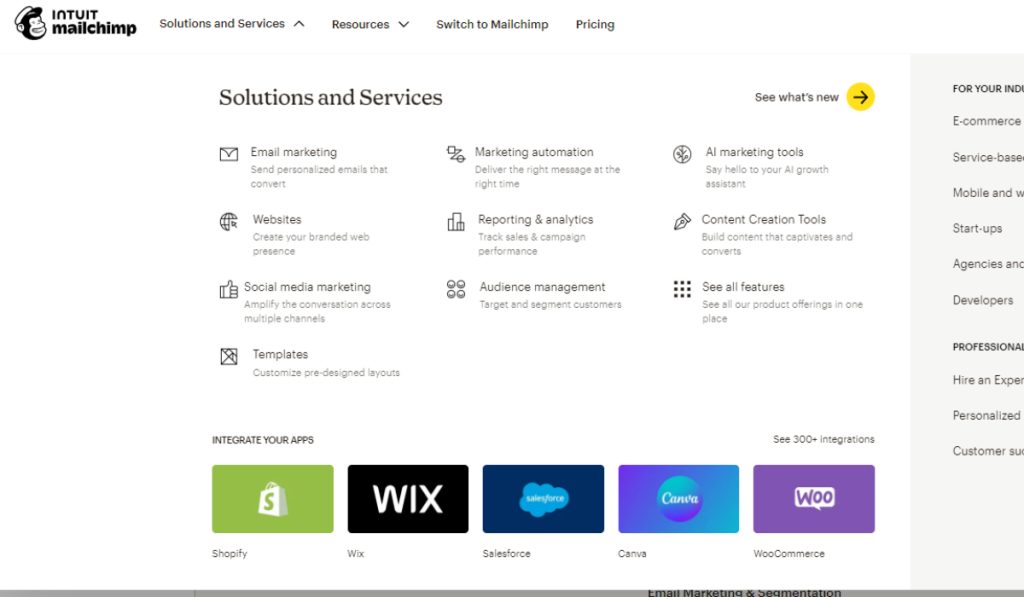
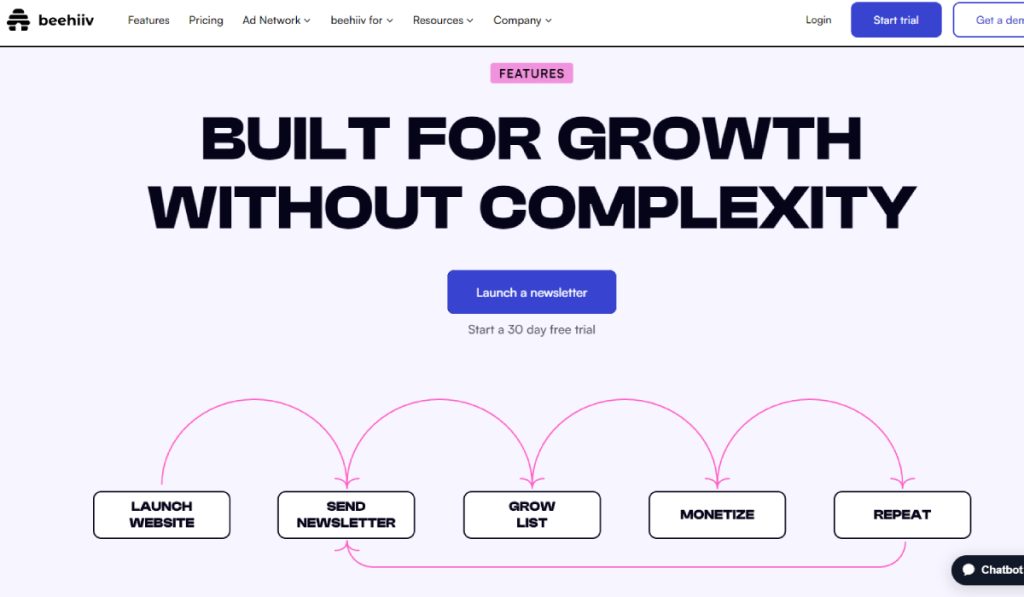
User Interface and Design
Mailchimp and Beehiiv both offer user-friendly interfaces, but with different focuses. Mailchimp’s drag-and-drop editor is renowned for its ease of use, making it accessible to users of all skill levels. It provides step-by-step email creation processes and comprehensive tutorials, allowing even non-designers to create professional-looking emails. The platform offers a wide range of customizable templates, further simplifying the design process.
Beehiiv, on the other hand, is known for its aesthetic and stylish templates, particularly appealing to content-focused newsletters and publications. Its intuitive drag-and-drop editor is designed for effortless creation of visually appealing newsletters. While both platforms prioritize user experience, Beehiiv’s design-centric approach caters specifically to creators and publishers who want more control over the aesthetics of their emails.
Automation Capabilities
In terms of automation, Mailchimp and Beehiiv offer distinct approaches. Mailchimp provides advanced automation tools that enable users to set up complex email campaigns triggered by specific actions or behaviors. This includes features like welcome emails, follow-up emails for abandoned carts, and detailed audience segmentation based on behavior, demographics, and engagement metrics. The platform’s A/B testing capabilities allow for optimization of email campaigns by testing different versions.
Beehiiv, while offering automation features, keeps its approach simpler and more straightforward. Its automation tools are designed to be easy to set up, making them accessible to users who may not need or want complex workflows. However, this simplicity may limit the depth of automation possibilities compared to Mailchimp’s more advanced offerings. The choice between the two depends on the level of automation complexity required for your email marketing strategy.
Pricing Structures
The pricing models of Mailchimp and Beehiiv differ significantly, catering to different business needs. Mailchimp’s pricing structure is based on the number of subscribers and features required. It starts with a free plan for up to 500 subscribers, with paid plans scaling up as the subscriber count increases. The Essentials plan begins at $9.99/month, while the Premium plan can go up to $299/month for larger lists and more advanced features. This model can become costly for rapidly growing lists.
In contrast, Beehiiv offers a simpler, flat-rate pricing structure with three plans: a free Launch Plan, a $42/month Growth Plan, and an $84/month Scale Plan. This pricing model can be more cost-effective for businesses experiencing quick growth, as it doesn’t penalize increasing subscriber counts. The choice between these pricing structures depends on your current list size, growth projections, and budget constraints.
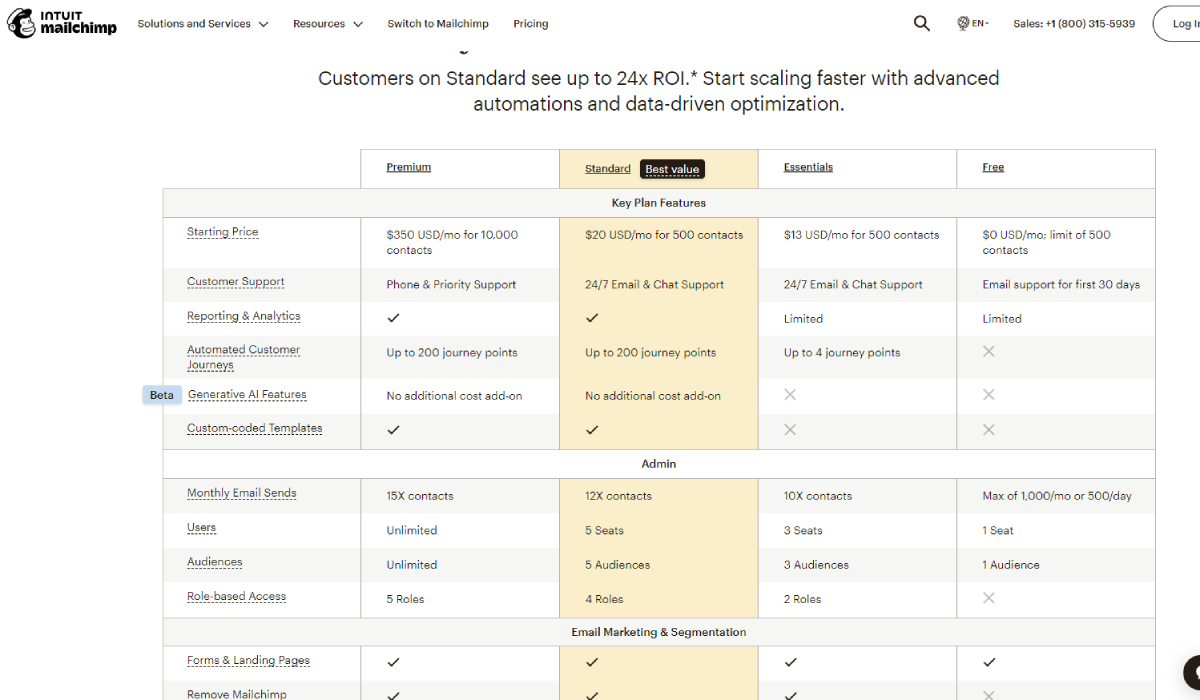
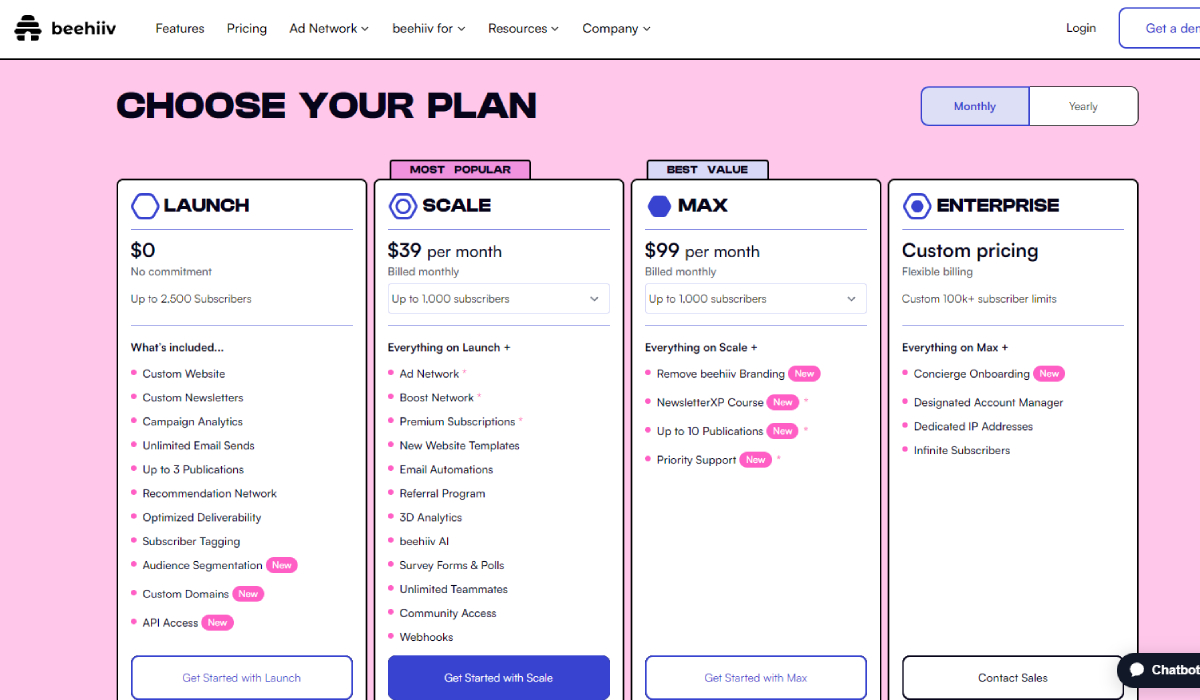
Integration and Ecosystem
Mailchimp and Beehiiv differ significantly in their approach to integrations and ecosystem building. Mailchimp excels in this area, offering integrations with a vast array of third-party apps, including social media platforms, e-commerce systems, and CRM tools. This extensive integration capability allows businesses to create a comprehensive and interconnected marketing ecosystem, enhancing the overall effectiveness of their digital marketing efforts. Mailchimp’s integrations enable seamless data flow between different platforms, facilitating more cohesive marketing strategies.
Beehiiv, while more limited in its native integrations, offers support through Zapier. This allows users to connect Beehiiv with other platforms, albeit in a less direct manner than Mailchimp’s native integrations. The choice between the two depends on how crucial extensive integrations are to your marketing strategy and the specific tools you need to connect with your email marketing platform.
Monetization Features
When it comes to monetization features, Beehiiv and Mailchimp offer different approaches. Beehiiv stands out with its built-in monetization tools, specifically designed for content creators and publishers. It supports premium subscriptions, allowing users to offer paid newsletter tiers to their audience. Additionally, Beehiiv provides an ad network, enabling content creators to generate revenue through targeted advertising within their newsletters. These features make Beehiiv particularly attractive for those looking to directly monetize their email content.
Mailchimp, while not offering direct newsletter monetization tools, provides robust e-commerce integrations. These integrations can indirectly support revenue generation by facilitating effective marketing for online stores and products. The choice between the two depends on whether you’re looking for direct newsletter monetization (favoring Beehiiv) or broader e-commerce marketing capabilities (favoring Mailchimp).
Hidden Gems
1. Utilize Beehiiv’s SEO-Friendly Blog Feature
Many users overlook the potential of Beehiiv’s integrated blog, which is optimized for search engines. By creating SEO-friendly content, you can attract organic traffic that converts into newsletter subscribers, a strategy not commonly emphasized in email marketing discussions. This feature allows your content to be discoverable online, driving continuous growth without additional advertising costs.
2. Leverage Mailchimp’s Advanced Automation for E-commerce
While Beehiiv offers basic automation, Mailchimp excels in e-commerce integrations. Use Mailchimp’s advanced automation to set up abandoned cart emails and personalized product recommendations, which can significantly boost sales for online stores. These automated workflows ensure that potential customers are nurtured effectively, increasing the likelihood of conversions and repeat purchases.
3. Implement Referral Programs in Beehiiv
Beehiiv provides built-in referral programs that are often underutilized. Encourage your current subscribers to refer others by offering incentives, which can lead to organic growth without additional marketing costs. Referral programs can harness the power of word-of-mouth marketing, expanding your subscriber base through trusted recommendations.
4. Use Mailchimp’s A/B Testing for Subject Lines
Many users do not fully leverage A/B testing capabilities in Mailchimp. Experiment with different subject lines to see what resonates best with your audience, as even small changes can lead to higher open rates. A/B testing allows you to make data-driven decisions, optimizing your email campaigns for maximum effectiveness.
5. Utilize Dynamic Content in Mailchimp
Many users are unaware of Mailchimp’s ability to personalize emails using dynamic content based on subscriber behavior. This can create a more tailored experience for each recipient, improving engagement and conversion rates. Dynamic content ensures that your emails are relevant and personalized, fostering stronger connections with your audience.
Innovative Solutions by Prism Reach
Company and Product Overview
Prism Reach is an innovative AI-powered SaaS solution designed to enhance the effectiveness of email marketing campaigns through deep personalization. This platform stands out by transforming how publishers and content creators engage with their audiences, using sophisticated AI algorithms to customize every aspect of newsletters based on subscriber behavior and preferences.
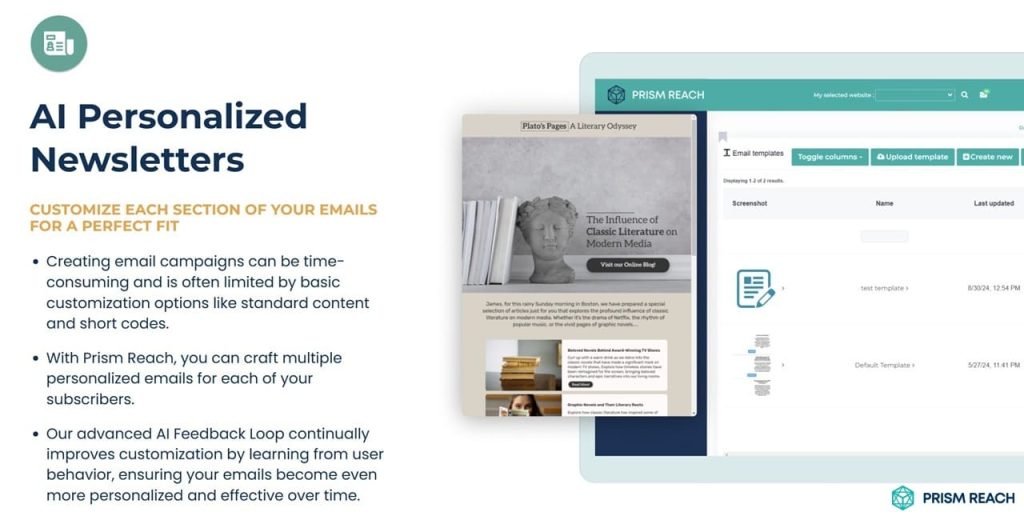
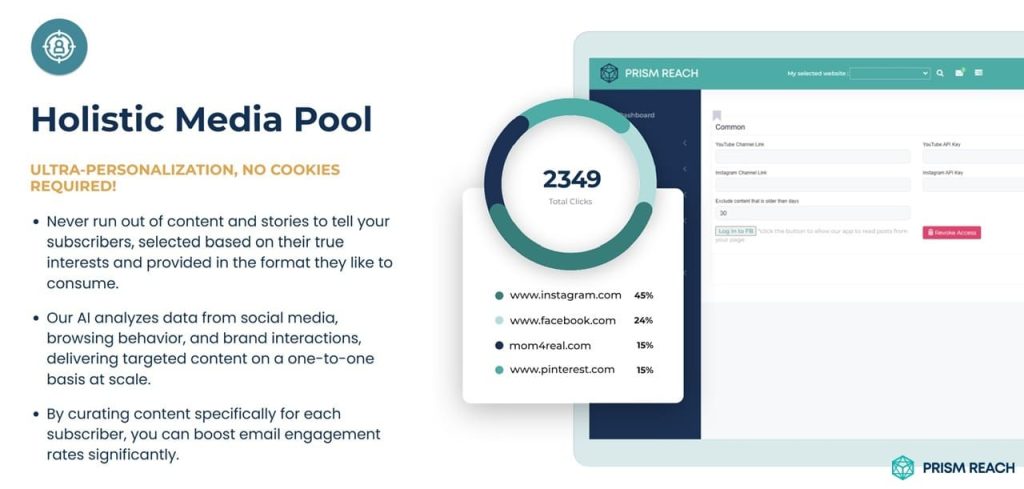
Prism Reach’s core functionality revolves around its proprietary AI technology, which clusters website content and social media posts into relevant categories. This AI uses a variety of data points to create detailed user avatars, enabling personalized newsletter content that incorporates factors such as location, engagement history, and predicted interests. The system’s ability to analyze vast amounts of data allows for highly targeted marketing strategies.
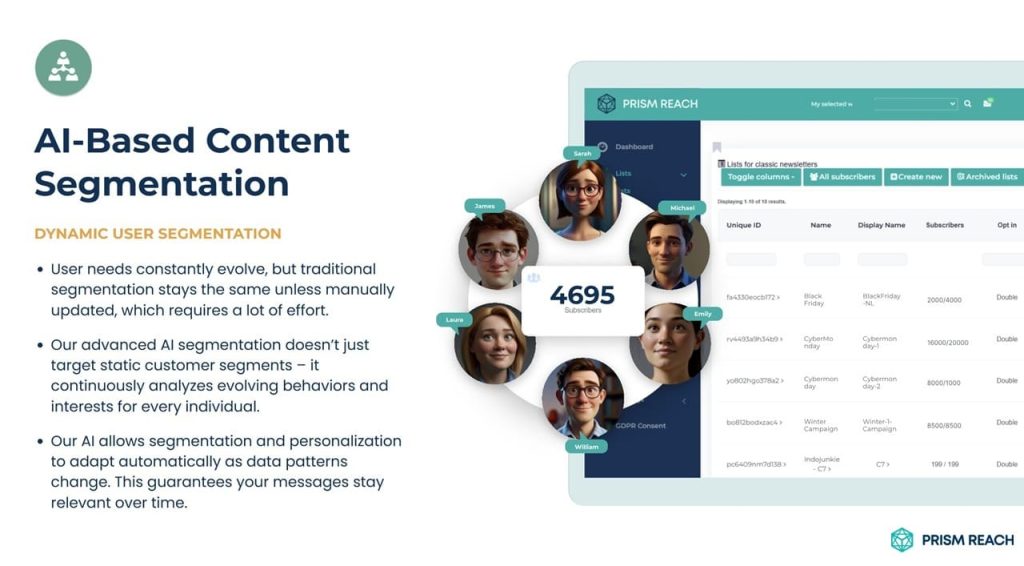
Target Audience
The primary users of Prism Reach are publishers across various platforms, including international media outlets, blogs, and forums. The company has also set its sights on expanding into the eCommerce sector, aiming to leverage its technology to enhance digital marketing efforts in this rapidly growing area.
Key Features
- AI-Powered Personalization:
- Content Clustering: Utilizes both open and proprietary AI models to categorize content effectively.
- User Avatars: Enriches user data for creating highly personalized profiles.
- Personalized Introductions: Generates custom introduction paragraphs for each subscriber using advanced data analytics.
- Optimal Sending Times: Uses predictive analytics to determine the best times to send newsletters, maximizing subscriber engagement.
- Seamless Setup and Integration:
- Quick Setup: The platform can be integrated within 10 minutes, making it user-friendly.
- One-Click Uploads: Facilitates easy migration of existing subscriber lists.
- AI-Enhanced Sign-Up Forms: These forms are designed to increase sign-up rates through AI-generated content tailored to the user’s context and improve GDPR compliance.
- Dynamic Content Selection: The AI determines the most relevant content for each subscriber, enhancing the personalization of each newsletter.
- Advertising Network and Swap Network:
- Provides a platform for targeted advertising similar to major online ad networks, allowing for precise ad placement based on subscriber data.
- Facilitates mutual promotion among publishers, broadening content reach and enhancing subscriber engagement.
- Advanced AI Features: Includes anti-spam checks and a focus on high deliverability, crucial for maintaining engagement levels and avoiding spam filters.
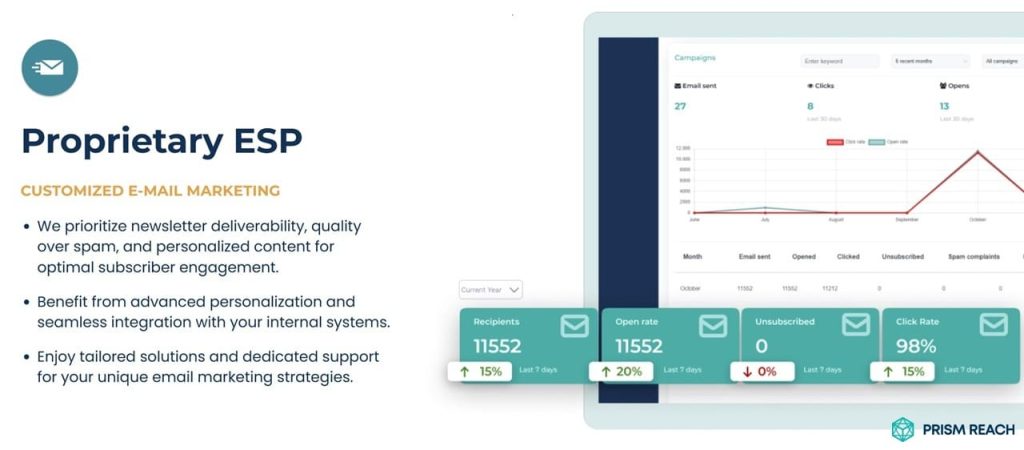
Benefits of Prism Reach
- AI-Powered Personalization: Enhances engagement by tailoring content to subscriber preferences, resulting in up to 40% higher engagement rates.
- Advanced Segmentation: Allows highly targeted campaigns, improving open and click-through rates through detailed audience segmentation.
- Seamless Integration: Easily integrates with existing platforms like Mailchimp and Beehiiv, streamlining marketing efforts and enabling a cohesive email marketing strategy.
Hidden Gem: Combine Mailchimp with Landing Pages
While Beehiiv focuses heavily on newsletters, integrating Mailchimp with dedicated landing pages can enhance lead generation efforts. Create targeted landing pages for specific campaigns to capture more leads effectively. This combination leverages Mailchimp’s robust email capabilities with landing pages designed to convert visitors into subscribers or customers.
Hidden Gem: Implement Referral Programs in Beehiiv
Beehiiv provides built-in referral programs that are often underutilized. Encourage your current subscribers to refer others by offering incentives, which can lead to organic growth without additional marketing costs. Referral programs can harness the power of word-of-mouth marketing, expanding your subscriber base through trusted recommendations.
Hidden Gem: Track Engagement Metrics in Real-Time with Beehiiv
Unlike Mailchimp, which provides standard reports, Beehiiv offers real-time analytics that allow you to adjust your strategy on the fly based on engagement metrics like open rates and click-through rates. Real-time tracking enables marketers to respond promptly to subscriber behavior, optimizing campaigns for better performance and higher engagement.
User Journey
The typical user journey with Prism Reach involves a streamlined process where subscribers sign up through a customized form, select their interests, and then receive personalized newsletters that cater specifically to their preferences. This journey not only enhances user satisfaction but also boosts the likelihood of long-term subscriber retention.
Compliance and Data Privacy
Prism Reach emphasizes GDPR compliance and hosts data within Europe, adhering to the highest standards of data protection. This focus on privacy is crucial for building trust with users and complying with international regulations.
Future Prospects
Looking ahead, Prism Reach aims to expand its technology into the eCommerce sector and explore new ways to leverage AI for broader marketing applications. The company is committed to the continuous improvement of its AI algorithms, ensuring that its solutions remain at the cutting edge of technology and marketing innovation.
Upgrade Your Email Marketing with AI Personalization!
Conclusion
In the Mailchimp vs Beehiiv debate, the choice ultimately depends on your specific needs and goals. Mailchimp remains a solid choice for businesses requiring extensive features and integrations, while Beehiiv offers an attractive option for content creators prioritizing aesthetics and simplicity.
However, for those seeking cutting-edge personalization and AI-driven insights, Prism Reach presents an intriguing alternative that could potentially offer the best of both worlds. Prism Reach’s AI-powered personalization takes email marketing to the next level, offering deep customization that goes beyond what traditional platforms provide. By leveraging AI to understand and predict subscriber preferences, Prism Reach delivers content that is not only relevant but also timely, enhancing the overall impact of digital marketing campaigns and fostering stronger connections between publishers and their audiences.